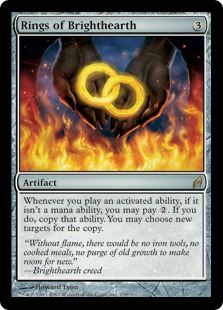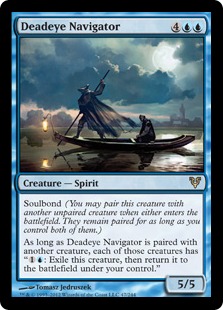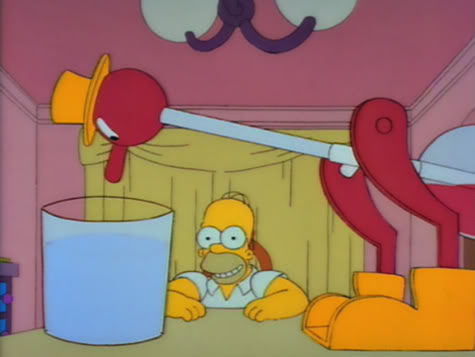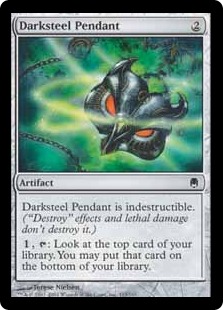“60% of the time, it works every time.”
If you’re a fan of the movie Anchorman, or you’ve just happened to be on the internet in the last few years, you’ve seen this line by Paul Rudd’s charmingly ignorant character, Brian Fantana. You’re also welcome to check out the scene.
Of course, those familiar with the movie are aware that Will Ferrell’s Ron Burgundy accurately points out that such a claim makes no sense. But we’re not here to discuss the cinematography of Will Ferrell. Honestly, outside of a few movies, I’m rather indifferent to his brand of comedy as a whole.
Yet this Anchorman anecdote is oddly relevant to our topic here today. Brian’s statement is blatantly ridiculous, and the audience is supposed to acknowledge that fact. The juxtaposition is what makes the scene funny. What isn’t funny, though, is that for many EDH players, they approach building a Commander deck like Brian approaches dating. Except it’s far less amusing.
Commander decks are 100 card amalgamations of different ideas, flavors, themes, play styles and mechanics. Ideally, each deck represents a unique construction crafted and honed by its owner to accomplish whatever objectives (beyond simply winning) that it’s trying to do. If 100 card decks were the model of efficiency, why would any player run a 60 card Constructed deck, or 40 in Limited? Instead of simply striving to win in the most expedient way possible, Commander decks exchange speed and streamlined behavior with added utility and card variety. From a Magic perspective, you can’t expect that the deck is going to behave identically every single time. Nor should you want to.
That last part bears repeating:
You do not want your Commander deck to work the same way every time.
Really.

Yay. Another flush…
Think of it this way: an EDH deck is almost the same size as two decks of standard playing cards. Imagine shuffling that deck and drawing five cards. Then imagine that those five cards are always Spades. If you were playing a poker game, that’d be respectable: a flush is a winning hand in many cases. However, not only will drawing the same five cards get pretty boring after a while when there’s almost 100 other cards available to you, but there are plenty of hands out there people could luck into that will still beat that nifty looking flush of yours.
The unpredictability of the unknown, of not being sure what you’ll draw, coupled with the thrill and luck of finding out, is what entices so many people to play games in general, let alone Magic: the Gathering. When you attempt to remove as much of the randomness as possible, it can grow stale. Once all luck is removed from a game, you end up with something like Chess, and at that point, it becomes a test of skill. However, if you’ve ever routinely lost to someone far more skilled at Chess than you – as most of us have at some point – it’s very apparent when there is a talent mismatch. You simply have no chance, and the game stops being fun. I would bet that repetitive flush hand of yours that repeatedly getting trounced in Chess by someone simply better is why so many people abandon their interest in the game shortly thereafter.
Magic has thousands more moving pieces than Chess does, though, and as a card game, it’s sort of impossible to eliminate the random hand of chance. What you see some people do instead, then, is to try to minimize it so much that it becomes close to the same thing. In EDH, this is done in two particularly frustrating ways: abusing combos and reliance on “staples”.
What Not To Do In EDH:
- Lesson One – Overused Commanders
- Lesson Two – Abusive Combos & Staples
- Lesson Three – Abandoning Theme
- Lesson Four – Wasting Time
Lesson Two, Part One: Abusing Combos
Long before EDH as we know it came into existence, a friend of mine once had a spell-based Blue / Red deck. The deck, well over 100 cards, was large even by our meta’s standards. (Most of our decks tend to be in the 75-95 range for a multitude of reasons.) This deck could have easily been retrofitted into the Commander format had it been around then, but it functioned surprisingly well since the deck had an impressive amount of synergy. It also had a particularly fun combo we affectionately referred to as “The Cannon”.

The root of many degenerative combos.
The Cannon revolved around getting out a Doubling Cube, Voltaic Key, and Rings of Brighthearth. Then you needed to dump 10 mana into the combo for it to ‘go infinite’, which in turn was used create a silly number of replicated Pyromatics. The Cannon amounts to a four card combo, requiring a 10 mana activation, that’s in a deck of over 100 cards, with little in the way of fetching the required pieces.
And it was bloody fantastic when it actually happened. So much so, in fact, that you couldn’t even really be upset. Hell, you were more likely to be impressed.
So many things could make such a combo fall apart. You could not draw the cards you needed, or you could never reach the 10 mana threshold. Plus, just removing one of the three required artifacts from the board was enough to shut The Cannon down, but the individual artifacts were innocuous enough on their own that they served no real threat individually.
Of course, the deck also had the old Niv-Mizzet, the Firemind + Curiosity combo (with a Clout of the Dominus for the kicker). Seeing that combo in action was far less impressive.
When building your Commander decks, opt for more Cannon and less Niv-Mizzet.
Games of Commander are supposed to be slow affairs. They take time to slowly ramp up into anything of consequence happening, and even longer for the games to resolve. The best Commander games will be lengthy and have many exciting twists and turns, where everyone has a chance of winning. You don’t want games where someone combos out a win in seven turns. In fact, I suggest everyone consider the first six turns in an EDH game to be the equivalent of one or two in any sort of Constructed format. If you want to combo out a win before your opponent even gets to play a land, go play Legacy.
In the same vein, anyone in Commander should be capable of responding to whatever you’re trying to do. Thus, the fewer moving parts to your win condition, the harder it is for anyone else to combat it. There’s little fun for most people to spend a half hour getting the board set up only for one person to alpha Johnny an uncounterable win right as the action really starts getting interesting.
There’s nothing wrong with creating fun and interesting combos, and even ‘going infinite’ in some fashion is fine if it takes effort to reach that point. It’s when those combos are fast, degenerative and / or non-interactive that we have a problem.
As a general rule, if you have an insanely powerful or game-ending combo, make sure it’s at least three cards. If it really only works with two cards, you have two crazy options: either don’t run a lot of tutoring, or don’t put that combo in your deck. It’s a novel concept, I know. Essentially, if you’re thinking of using a combo in your deck, follow Wheaton’s Law – Don’t Be A Dick.

Oh, abusing Deadeye? How completely original.
What sort of stuff are we talking about? Just off the top of my head:
Building your own Cannon of Rings + Voltaic Key + One of Several Artifacts is fine. Doing so by using Rings and Basalt Monolith, not so much.
Goblin Sharpshooter + deathtouch (i.e. Basilisk Collar) or Thornbite Staff + Avatar of Woe. Exquisite Blood + Sanguine Bond. Mikaeus, the Unhallowed + Triskelion. Staff of Domination + any creature that taps for five mana. Pemmin’s Aura + any creature that taps for two mana. Leyline of the Void + Helm of Obedience. Splinter Twin + any creature that untaps when it or something else enters the battlefield.Pretty much anything with Kiki-Jiki, Mirror Breaker, Deadeye Navigator, or Intruder Alarm
Et cetera, et cetera, et cetera…
If your combo comes up fast and has little recourse in the way of being stopped, consider using something different. I know the thought of not executing an uber powerful move will cause some people actual physical pain as they try to process that concept, but using these combos doesn’t make you clever or original. Commander is a fantastic outlet for being clever and original. Take advantage of it.
Lesson Two, Part Two: Abusing Staples
In the same line of thought, the latter half of this lesson should be another no-brainer. I’ve talked about this particular topic before and at length, but it bears repeating. Commander lets you build decks of 100 different cards, allowing for a wide spectrum of interesting and innovative card uses. It makes old cards new again and gives a place to new cards that would otherwise never see use in normal decks. So, why why why why why would you continually put the same cards in your deck over and over again?

I wonder if he’ll do anything different this time…
We all get the allure of cards that are repeatedly on the short list time after time. Rhystic Study is great to get out early. A Sol Ring is always nice, and who wouldn’t want to throw a Swiftfoot Boots, Solemn Simulacrum, Sylvan Library, or Sensei’s Divining Top in for good measure?
While we’re at it, let’s add an Akroma’s Vengeance, Demonic Tutor, and an Insurrection to the mix. Then top it all off with a Cyclonic Rift and a Phyrexian Metamorph, because screw it, I’ll still have 10 slots to be creative with.
Although it never appears to be the case at inception, 100 card slots fill up quickly. The more of these insisted upon staples you bank on, the less room you have to really experiment with different cards and innovative combinations.
To take full advantage of expressing your individuality in Commander, focus on cards that are thematic and flavorful to your deck as a whole over the perceived ‘must haves’ of a deck. Few argue that Rhystic Study is bad, for instance, but that doesn’t mean it should be added to every Commander deck with Blue in it. There are over 30 Blue Enchantments alone that let you draw cards, and while not all of them are amazing, always relying on Rhystic likely means you won’t have the opportunity to even consider other cards like Mystic Remora, Zur’s Weirding, Thought Reflection or Honden of Seeing Winds.
All constantly using staples does is not-so-subtly state that you’re building your deck to win first and maybe have an original thought second.

Another good Top alternative.
Commander is ultimately about casual play. That means enjoying the games you play with your friends and coming up with tricky and unique ways to build a deck. If you’re playing Commander, that’s where your mindset should be. Cut the shit with overpowered two-card combos and try to use something besides Sylvans and Sensei’s. (Crystal Ball is a nice choice, for example. It’s also, quite literally, 99% cheaper to acquire.)
If you only ever focus on winning EDH games, you’ll find that you’ve built your deck to behave the same way time after time, offering little in the way of handling those unexpected turn of events. In the end, if you’re making the same repetitions in a format designed to be lengthy and varied, you’re either bound to lose interest in the format, or players will lose interest in playing with you. And that’s hardly a win for anyone.
In the next segment, we’ll explore the importance of theme. Until then, may you find your own impractically powerful Cannon to build.
![]()
What combos do you hate to deal with, or staples you hate to see? Tell us over on our social media or by contacting the author at ryan@cardboardrepublic.com
Photo Credits: Simpsons by 20th Century Fox.
